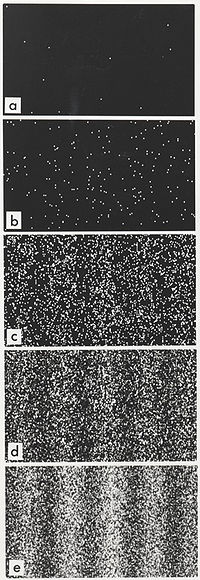A-level Physics (Advancing Physics)/Electron Behaviour as a Quantum Phenomenon
So far, we have considered how quantum physics applies to photons, the quanta of light. In reality, every other particle is also a quantum, but you only need to know about photons and electrons.

The image on the right shows what happens when you fire electrons through a pair of slits: it arrives in lumps, but you get fringes due to superposition as well. The electrons are behaving as both waves and particles. Actually, they are behaving as quanta. The equations describing quantum behaviour in electrons are similar to those describing it in photons.
Frequency and Kinetic Energy edit
We know that, for photons:
In suggesting that electrons are quanta, we assume that they must have a frequency at which the phasors representing them rotate. We also know that h is a constant; it does not change. So, when adapting the above equation to apply to electrons, all we need to adapt is E. In electrons, this energy is their kinetic energy. If the electron has some form of potential energy, this must first be subtracted from the kinetic energy, as this portion of the energy does not affect frequency. So:
De Broglie Wavelength edit
If electrons exhibit some wavelike properties, they must also have a 'wavelength', known as the de Broglie wavelength, after its discoverer. This is necessary in order to work out a probability distribution for the position of an electron, as this is the distance the electron travels for each phasor arrow rotation. The de Broglie wavelength λ is given by the equation:
,
where h = Planck's constant, p = momentum, m = mass of electron = 9.1 x 10−31kg and v = velocity of electron.
Potential Difference and Kinetic Energy edit
Potential difference is what causes electrons to move. You already know how power is related to charge, voltage and time:
Since power is the rate at which work is done:
We know that the charge on an electron equals -1.6 x 10−19, and that work done is energy, so:
Energy, in the SI system of units, is measured in Joules, but, sometimes it is measured in electronvolts, or eV. 1 eV is the kinetic energy of 1 electron accelerated by 1V of potential difference. So, 1 eV = 1.6 x 10−19 J.
Questions edit
1. An electron moves at 30,000 ms−1. What is its de Broglie wavelength?
2. What is its frequency?
3. What is its kinetic energy, in eV?
4. Given that it is travelling out of an electron gun, what was the potential difference between the anode and the cathode?
5. An electron is accelerated by a potential difference of 150V. What is its frequency?